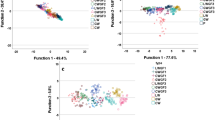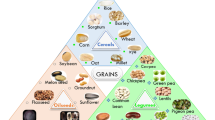Abstract
Quality improvement of cereal brans, a health promoting ingredient for functional foods is the emerging research concept due to their low shelf stability and presence of non-nutrient components. A study was conducted to evaluate the storage quality of processed milling industry byproducts so that these can be potentially utilized as a dietary fibre source. Different cereal brans (wheat, rice, barley and oat) were processed by dry, wet, microwave heating, extrusion cooking and chemical methods at variable conditions. Processed brans were stored in high density polyethylene (HDPE) pouches at ambient and refrigeration temperature. Quality assessments (moisture, free fatty acids, water activity and physical quality) of brans were done up to six months, at one month intervals. Free fatty acid content, moisture and water activity of the cereal brans remained stable during the entire storage period. Among treatments, extrusion processing is the most effective for stability. Processing treatments and storage temperature have the positive effect on extending the shelf life of all cereal brans. Therefore, processed cereal brans can be used as a dietary fortificant for the development of value added food products.

Similar content being viewed by others
Abbreviations
- AACC:
-
American Association of cereal chemists
- AOAC:
-
Association of Official Analytical Chemists
- ADF:
-
Acid detergent fiber
- NDF:
-
Neutral detergent fiber
- FFA:
-
free fatty acid
- HDPE:
-
High density polyethylene
- g/ml:
-
gram per milliliter
References
AACC (2000) Approved methods of american association of cereal chemists, 10th edn. The Association St, Paul
Anon (2001) Official methods of analysis, 16th edn. The Association of official analytical chemists, Washington
Barber S, Benedito-de BC (1980) Rice bran: chemistry and technology. In: Luh DS (ed) Rice production and utilization. AVI Pub. Co., Westport
Butt MS, Nasir M, Akhtar S, Sharif K (2009) Effect of moisture and packaging on the shelf life of wheat flour. Internet J Food Safety 4:1–6
Egan H, Kirk RS, Sawyer R (1981) Pearson’s chemical analysis of foods, 8th edn. Churchill Livingstone, Logman Inc., New York, USA.
Fernandez-Artigas P, Guerra-Hernandez E, Garcia-Villanova B (1999) Browning indicators in model system and baby cereals. J Agric Food Chem 47:2872–2878
Hoffpauer DW, Light Heart LCC, Crowley LA (2005) New application for whole rice bran. Cereal Foods World 50:173–174
James C, Sloan S (1984) Functional properties of rice bran in model system. J Food Sci 49:310–311
Kaur G, Sharma S, Nagi HPS, Dar BN (2011) Functional properties of pasta enriched with variable cereal brans. J Food Sci Technol. doi:10.1007/s13197-011-0294-3
Kay RM, Truswell AS (1980) Dietary fibre: effects on plasma and binary lipids in man. In: Spiller GA, Kay RM (eds) Medical aspects of dietary fibre. Plenum Press, New York, p 183
Khan SM, Butt MS, Anjum FM, Jamil A (2009) Antinutritional appraisal and protein extraction from differently stabilized rice bran. Pakistan J Nutr 8:1281–1286
Lakkakula NR, Lima M, Walker T (2004) Rice bran stabilization and rice bran oil extraction using Ohmic heating. Bioresour Technol 92:157–161
Lebesi DM, Tzia C (2011) Effect of the addition of different dietary fiber and edible cereal bran sources on the baking and sensory characteristics of cupcakes. Food Bioprocess Technol 4(5):710–722
Lee S, Inglett GE, Carriere CJ (2004) Effect of Nutrim oat bran and flaxseed on rheological properties of cakes. Cereal Chem 81:637–642
Lin MJ, Humbert ES, Sosuliski FW (1974) Certain functional properties of sunflower meal products. J Food Sci 39:368
Malekian F, Rao RM, Priyawiwatkul W, Marshall WE, Windhauser M, Ahmedna M (1999) Lipase and lipoxygenase activity, functionality, and nutrient losses in rice bran during storage. Bulletin number 870, LSU Agcenter, Baton Rouge, LA 70803.
Malekian F, Rao RM, Priyawiwatkul W, Marshall WE, Windhauser M and Ahmedna M (2000) Lipase and lipoxygenase activity, functionality, and nutrient losses in rice bran during storage. Bulletin Number 820, Louisiana Agricultural Experimental Station Deparment of Food Science, Louisiana State University Baton Rouge, LA, 70803, pp. 4–40.
Manthey FA, Sinha S, Wolf Hall CE, Hall CA (2008) Effect of flaxseed flour and packaging on shelf life of refrigerated pasta. J Food Proc Preserv 32:75–87
Prabhakar JV, Venkatesh KVL (1986) A simple chemical method for stabilization of rice bran. J Am Oil Chem Soc 63:644–646
Priyankara SKA, Weerathilake WADV (2009) Effect of vaccum and polybag packing on simple and microwave heat treated parboiled rice bran. J Anim Sci 9–16. Number 1253105818.
Randall JM, Sayre RN, Schultz WG, Fong RY, Mossman AP, Tribelhorn RE, Saunders RM (1985) Rice bran stabilization by Extrusion Cooking for extraction of edible oil. J Food Sci 50:361–365
Robertson JB, Van Soest PJ (1981) The detergent system of analysis and its application to human foods. In: James WPT, Thrander O (eds) The analysis of dietary fiber. Marcell Dekker, New York, pp 123–158
Sayre RN, Saunders RM, Enochian RV, Schultz WG, Beagle EC (1982) Review of rice bran stabilization systems with emphasis on extrusion cooking. Cereal Foods World 27:317–322
Sekhon KS, Dhillon SS, Singh N, Singh B (1997) Functional suitability of commercially milled rice bran in India for use in different food products. Plant Food Hum Nutr 50:127–140
Sharma HR, Chauhan GS, Agarwal K (2004) Physico-chemical characteristics of rice bran processed by dry heating and extrusion cooking. Int J Food Prop 7:603–614
Singh S, Bansal ML, Singh TP, Kumar R (1998) Statistical methods for research workers. Kalyani Publishers, New Delhi
Sosulski FW (1962) The centrifuge method for the flour water absorption in hard red spring wheat. Cereal Chem 39:344–350
Talab KT, Shabedi M, Shokrani R, Dokhani S (2002) Stabilization of rice bran oil by inactivation of its lipase and lipoxidase. Iran J Agric Sci 33:593–603
Thebaudin JY, Lefebvre AC, Harrington M, Bourgeois CM (1997) Dietary fibers: nutritional and technological interest. Trends Food Sci Technol 8:41–48
Acknowledgement
The financial support from the Council of Scientific and Industrial Research (CSIR) New Delhi is gratefully acknowledged.
Author information
Authors and Affiliations
Corresponding author
Rights and permissions
About this article
Cite this article
Sharma, S., Kaur, S., Dar, B.N. et al. Storage stability and quality assessment of processed cereal brans. J Food Sci Technol 51, 583–588 (2014). https://doi.org/10.1007/s13197-011-0537-3
Revised:
Accepted:
Published:
Issue Date:
DOI: https://doi.org/10.1007/s13197-011-0537-3




